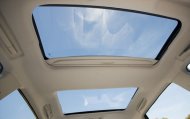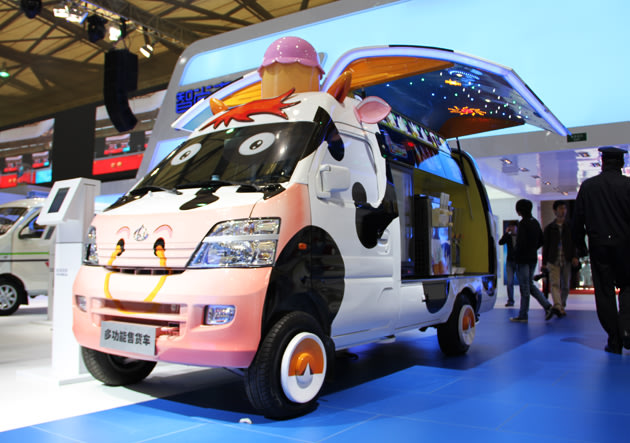
Granted, there's not much edgy or daring about crossovers anymore, contrary to what the marketing departments want you to think. The unibody, car-based tall wagon is about as ubiquitous now as the mid-sized, truck-based SUV was in the early to mid-90s. The Venza is a relative latecomer to the scene, with the trail blazed by the pre-Facebook era Nissan Murano way back in 2002 as a 2003 model. Ford followed with the Edge for the 2007 model year, and Honda with its oddly proportioned Accord Crosstour in 2009, around the same time the Venza debuted.
In total passenger volume, the Highlander trounces the Venza by more than 37 cubic feet. In cargo capacity, the Venza's Celtic-themed kin bests it by more than 10 cubic feet with the rear seats up, and by a substantial 25 cubic feet with the rear seats folded. Max towing capacity on the Highlander is also 1500 pounds greater than on the Venza, with a nearly identical powertrain. The key difference? The V-6 Highlander still soldiers on with a five-speed automatic, while the V-6 Venza gets a six-speed.
The one, and increasingly important, area in which the Venza bests its larger sibling is fuel economy. The all-wheel-drive V-6 Highlander rates 17/22 on the EPA cycle, with the sleeker, 400-pound lighter Venza AWD returning 18/25. For those seeking even greater fuel economy, the Venza is also available with a 2.7-liter four-cylinder shared with the base Highlander that returns 21 city and 27 highway mpg on the front driver, and 20/25 on the all-wheel-drive model. Considering the minimal fuel economy penalty with the V-6, and the fact it offers 86 more horsepower, go with the six.
Speaking of the engine, it's Toyota's familiar 3.5-liter mill, found in everything from the RAV4 to the Highlander, Sienna Minivan, Camry, and Avalon, as well as the Lexus RX 350. As expected from a Toyota six-cylinder, noise, vibration, and harshness are well-subdued, and power output is sufficient for the vehicle's weight. However, with a curb weight of slightly more than two tons on the AWD model, the sensation of 268 horsepower isn't quite as stirring as it would be in a 500-pound lighter Camry or RAV4.
As with many current Toyotas, the driving experience isn't especially engaging. However, considering the vehicle's intended mission, canyon-carving probably wasn't a high priority on the suspension engineers' checklist. Getting back to the theme of sacrificing function for beauty, however, the 20-inch wheels deliver a ride firmness that hints at handling prowess that the suspension simply can't deliver. Taking a corner at anything more than a moderate pace elicits screeches and and howls from the tires. Appreciate the dubs for their style, but don't expect dramatic performance.
Although the Venza cuts an unmistakably dashing profile on the outside, the interior is a mixed bag. There's nothing exceptionally objectionable about the styling or materials, but the interior does not have the same cohesiveness and elegance as the exterior. There's an odd, indeterminate texture applied across much of the interior plastic that is an attempt at a woodgrain or faux leather, but succeeds at neither. A similar and more subdued texture is applied on the leather seats, and it works a little better, but still comes across as a bit contrived.
Ergonomically, the Venza is somewhat of an adjustment. When I first sat down and oriented myself with the controls, I looked around for a display readout for the air conditioning controls. Somewhat counterintuitively, the temperature and fan settings are displayed on a 3-inch-square LCD display in the middle of the dashboard, up high in a central unibrow area. It's not that jarring once you get used to it, but the placement seems like an afterthought.
Compared to its most logical peers, the Honda Crosstour, Nissan Murano, and Ford Edge, the Venza offers similar capabilities. Comparably equipped, the prices are pretty close, too. So what is there to recommend the Venza over its rivals? Well, if you're predisposed to think favorably of Toyota products, it has that going in its favor. It's the best-looking of the bunch, especially from a rear three-quarter angle. However, the interior has the oddest layout and materials.
Toyota often has mixed results when it tries to be too edgy, and the Venza is a rolling example. While the exterior is stylish and eye-catching, the interior is an odd mishmash of unique and parts-bin, premium and low-rent. If I were in the focus group for a mid-cycle refresh, I would suggest a revamp of the interior, using soft-touch, conventionally textured plastics, quality leathers, and contrast stitching. And perhaps some memory functions for the steering wheel adjustment and driver's seat.
The danger in moving too upscale with the Venza is that it would quickly start stepping on the toes of its more patrician cousin, the Lexus RX, in both price and market positioning. Such is the peril when you also have a luxury brand in your portfolio.
As it stands, the Venza is a stylish alternative to the conventional midsize SUV, and would likely fit the needs of small (two or fewer children) families looking for day-to-day family transport. With some fine-tuning to the interior trim, it could be a great crossover instead of a good one.

















